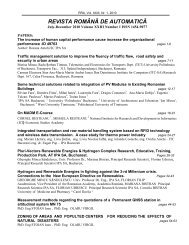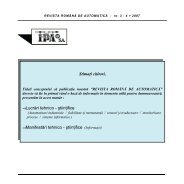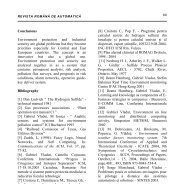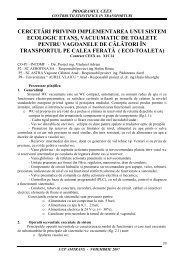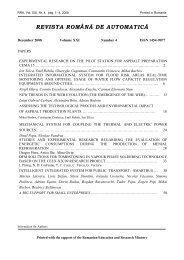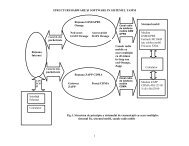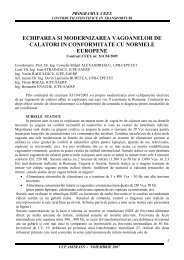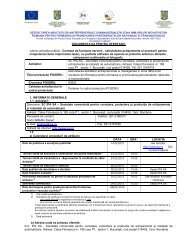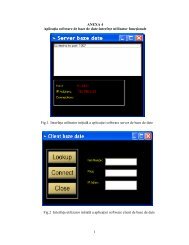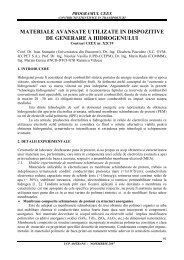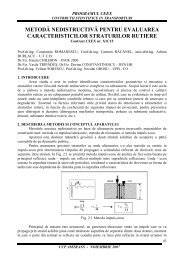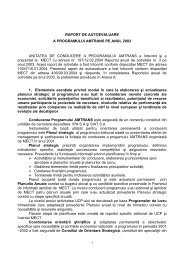Part II - IPA SA
Part II - IPA SA
Part II - IPA SA
You also want an ePaper? Increase the reach of your titles
YUMPU automatically turns print PDFs into web optimized ePapers that Google loves.
REVISTA ROMÂN DE AUTOMATIC<br />
39<br />
PARTIAL DISCHARGE MONITORING<br />
All the components used for the <strong>Part</strong>ial<br />
Discharge (PD) monitoring, including<br />
capacitive couplers, HydroTrac units and<br />
special software, was procured from IRIS<br />
Power, a Canadian company. The <strong>Part</strong>ial<br />
Discharge system was used for two of the<br />
four hydro generators, the generators with a<br />
voltage of 10,5 kV.<br />
In 1994, IRIS [2] installed the world’s first<br />
commercial continuous on-line partial discharge<br />
measuring system for large generators.<br />
The IRIS HydroTrac system was released in<br />
2000. The <strong>Part</strong>ial Discharge testing has<br />
become the most pervasive tool for assessing<br />
the condition of the stator winding insulation<br />
during normal operation of a hydro generator.<br />
Typical winding aging condition, which can be<br />
detected by partial discharge testing, include:<br />
- loose wedges;<br />
- insulation delaminating;<br />
- separation of copper-insulation bond;<br />
- deterioration of semi-conducting<br />
coating;<br />
- damaged semi-conducting/grading<br />
coating overlap area;<br />
- cracks on winding insulation;<br />
- problems related to thermal,<br />
mechanical, and/or electrical aging of<br />
the insulation.<br />
The results of PD testing are generally<br />
summarized by two key indicators or<br />
summary numbers: NQN and Qm. These two<br />
factors are derived from the standard pulse<br />
height analysis plots obtained from a PD test.<br />
- NQN is the area under the pulse<br />
height analysis curve, and represent the total<br />
PD activity and indicate the increasing<br />
insulation aging.<br />
- Qm is the magnitude, in mV, of the<br />
largest PD pulses detected and is indicative of<br />
the worst deterioration within the machine.<br />
For each of the two 10,5kV hydro generator<br />
was allocated a HydroTrac unit. The two<br />
units were connected, via an RS-485 network,<br />
to the central DS2 diagnosis station.<br />
OTHER DATA MONITORING<br />
The other data, which were necessary to be<br />
monitored, are obtained from the SCADA<br />
system, elaborated by ABB Germany, via an<br />
OPC server – OPC client connection in which<br />
ABB is the server and <strong>IPA</strong> is the client.<br />
As OPC client, <strong>IPA</strong> has used the RSView32<br />
base software from the Rockwell Automation<br />
Company. The process parameters, which are<br />
taken over in this way, for analysis, are the<br />
following:<br />
• Hydro generator stator winding, iron<br />
core and bearing temperature;<br />
• Cooling water, cooling air and oil<br />
temperature;<br />
• Guide vane opening;<br />
• Grate clogging level;<br />
• Water upstream and downstream<br />
level;<br />
• Circuit breakers and protections<br />
state;<br />
• Voltage and current in the 0,4 kV<br />
circuits;<br />
• Oil and cooling water pumps<br />
running hours.<br />
These information are used to give, for<br />
example, a statistical image about the<br />
frequency of circuit breakers disconnecting or<br />
about how many times a winding temperature<br />
has exceed a certain value and at what time.<br />
All these data are archived, to be used for a<br />
long time diagnosis trend display, or to be<br />
edited in a printed report.<br />
REFERENCES<br />
[1] VibroSyst M “On line monitoring of<br />
hydro generating units for optimized<br />
operations and maintenance”.<br />
[2] B.A. Lloyd and G.C. Stone – Iris Power<br />
Engineering – “Experience with continuous<br />
on-line stator winding partial discharge<br />
monitoring of hydro generators”.<br />
AR934-8.doc



